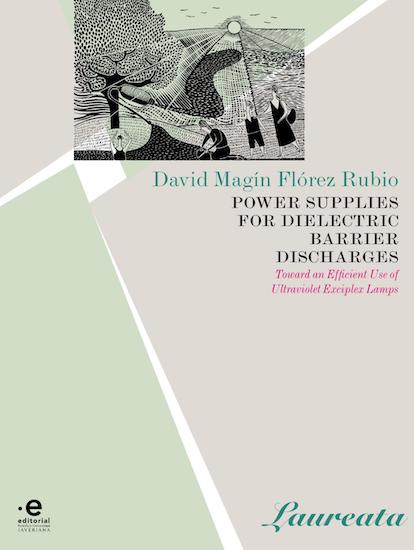The Dielectric Barrier Discharge (DBD) Excimer Ultra-Violet (UV) lamps are a promising technology offering several advantages over other sources of UV light. In particular, the application of this type of lamps for drinking water treatment could benefit thousands of people in regions where public access to drinking water is not provided. To optimize the performance of the DBD Excimer UV lamps, a novel power system, intended for the study of this technology has been designed and implemented. This system employs a customized high frequency-high voltage current mode supply that allows adjusting the point of operation and the power injected in DBD lamps precisely. Using this innovative equipment, the operating conditions that optimize the UV output of the DBD Excilamps have been found. Based on the results of these studies, an innovative converter featuring high efficiency, zero current switching, and enhanced to work at an optimum operating point of the lamp was conceived and validated. The analytical development of the converters is described in detail providing useful equations applicable for pulsed power supplies for all types of DBD reactors. The discoveries of this research show that it is possible to increase the performance of DBD Excilamps based on the operating conditions of the power supply and also to obtain high electrical efficiency in the complete system. These results are crucial contributions to overcome technical, performance and implementation barriers, which have been obstacles to the transfer of this promising technology to the industry.
- Acknowledgements
- 1 Introduction
- 1.1 What is Ultra-Violet (UV) Radiation Useful for?
- 1.2 Artificial UV Sources
- 1.3 Main Advantages of DBD Excilamps
- 1.4 DBD Excilamps Technology Landmarks
- 1.5 Improvement Opportunities
- 1.6 Objectives
- 2 Literature Review
- 2.1 DBD Excimer UV Lamps
- 2.1.1 Operating Principle
- 2.1.2 UV Production
- 2.1.3 Operating Conditions
- 2.1.4 Modeling
- 2.2 Power Supplies for DBDs
- 2.2.1 Controlling DBD excilamp power
- 2.2.2 Current Mode Supplies for DBDs
- 2.2.3 Voltage Mode Supplies for DBD
- 2.3 Characteristics of Commercial DBD Excilamp Based Systems
- 2.4 Summary
- 3 Parametric Control of DBD Excilamp Electrical Power
- 3.1 Control of Lamp Power with Three Degrees of Freedom
- 3.1.1 Choice of the Current Waveform
- 3.1.2 Lamp Power Computation
- 3.2 Square-shape Current Supply Design
- 3.2.1 Current Inverter Operation
- 3.2.2 Constant Current Source
- 3.3 Considerations for Implementation
- 3.3.1 Frequency of the Lamp Current
- 3.3.2 Output Current and Voltage
- 3.3.3 The Step-up Transformer
- 3.4 Components Selection
- 3.4.1 Transformer
- 3.4.2 Inductance
- 3.4.3 Switches
- 3.5 Implementation Results
- 3.5.1 User Interface for the Operating Point Adjustment
- 3.5.2 Experimental Bench
- 3.5.3 Lamp Power Adjustment
- 3.5.4 Efficiency
- 3.5.5 UV radiation
- 3.6 Conclusions
- 4 Parametric Study of the Operating Point Influence on DBD Excilamp Performance
- 4.1 Experimental Set-up
- 4.2 Impact of Lamp Current Intensity
- 4.2.1 Impact of Over the UV Production
- 4.2.2 Impact of J on the Electrical and UV Waveforms
- 4.2.3 Impact of J on Lamp Model Parameters
- 4.2.4 Impact of J on the Discharge Regime
- 4.3 Impact of the Lamp Operating Frequency
- 4.3.1 Impact of on UV Production
- 4.3.2 Impact of on the Electrical and UV Waveforms
- 4.3.3 Impact of f Over the Lamp Model Parameters
- 4.3.4 Impact of on the Discharge Regime
- 4.4 Best Performance Operating Conditions
- 4.5 Conclusions
- 5 High Efficiency DBD Power Supply Working at the Optimal Operating Point
- 5.1 Topology: SRI Operated in DCM
- 5.1.1 State plane analysis
- 5.1.2 State plane: before breakdown trajectory
- 5.1.3 State plane: after breakdown trajectory
- 5.1.4 Operating conditions
- 5.2 Components Selection and Simulations
- 5.2.1 Operating Point
- 5.2.2 Switches
- 5.2.3 Step-up Transformer
- 5.2.4 Inductance Value
- 5.2.5 Simulations
- 5.3 Experimental Results
- 5.3.1 Electrical Waveforms
- 5.3.2 Performances
- 5.4 Conclusions
- 6 DBD Supplies Comparison
- 6.1 Analytical Design
- 6.1.1 Boost Based Converter
- 6.1.2 buck-boost based converter
- 6.2 Converters Design and Simulations
- 6.2.1 SRI design
- 6.2.2 Boost-based design
- 6.2.3 Buck-boost-based design
- 6.2.4 Square-shape design
- 6.2.5 Simulations
- 6.3 Experimental Results
- 6.4 Conclusions
- 7 Application Case: KrCl DBD UV Excilamp Germicidal Effectiveness
- 7.1 Procedures and Resources
- 7.1.1 The UV Source
- 7.1.2 Microorganisms under evaluation
- 7.1.3 Irradiance procedure
- 7.2 Results
- 7.2.1 Bacteria indicators
- 7.2.2 Clostridium perfringens
- 7.2.3 Virus indicators
- 7.2.4 Parasites: Cryptosporidium spp and Giardia spp
- 7.3 Conclusions
- 8 General Conclusions
- Bibliography

